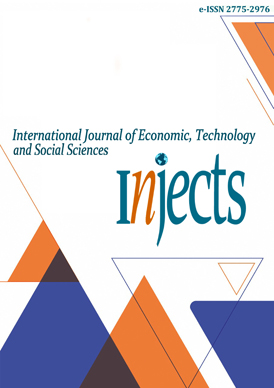Antecedents of Iphone Product Purchase Decision at Medan Area University Students
DOI:
https://doi.org/10.53695/injects.v2i2.508Keywords:
price, product quality, lifestyle, purchasing decision.Abstract
This study aims to influence the purchasing decisions of iPhone products for students at Universitas Medan Area. The type of research used is explanatory with a quantitative approach. The population in this study were students of Universitas Medan Area who used Iphone smartphones totaling 965 people. The number of samples is 90 respondents using purposive sampling and data collection methods using questionnaires. The data analysis used is Multiple Linear Analysis. Based on the results of the t test, it can be explained that the price, product quality, and lifestyle partially have a significant effect on the iPhone smartphone purchase decision on Universitas Medan Area students. The results of the coefficient of determination analysis can be explained that the price, product quality and lifestyle influence the decision to buy Iphone for students at Universitas Medan Area.References
Adnan, A. and Khan, M.N. (2017) ‘Scale development and refinement of a lifestyle instrument’, Int. J. Knowledge Management in Tourism and Hospitality, Vol. 1, No. 2,
pp.127–151.
Ahmad, N., Omar, A., & Ramayah, T. (2012, June). Examining the validity and reliability of elifestyles scale in the malaysian context: a preliminary results. In The 3rd International
Conference on Technology and Operations Management (ICTOM) Conference Proceedings (pp.589-597).
Ahmad, N., Omar, A., & Ramayah, T. (2014). A lifestyles study on purchasing behavior of
Malaysian online consumers.
Bloch, P.H. (1995), “Seeking the ideal form: product design and consumer response”, Journal of Marketing, Vol. 59 No. 3, pp. 16-29
Chen, K. K. (2014). Assessing the effects of customer innovativeness, environmental value and
ecological lifestyles on residential solar power systems install intention. Energy Policy, 67, 951-961.
Crilly, N., Moultrie, J. and Clarkson, P.J. (2004), “Seeing things: consumer response to the visual domain in product design”, Design Studies, Vol. 25 No. 6, pp. 547-577.
Chan, R.Y. and Lau, L.B. (2000), “Antecedents of green purchases: a survey in China”, Journal of Consumer Marketing, Vol. 17 No. 4, pp. 338-357.
Garvin, D. A. (1988). Managing Quality. New York: The Free Press
Havighurst, R. J., & Feigenbaum, K. (1959). Leisure and life-style. American Journal of
Sociology, 64(4), 396-404.
Harian analisa, 4 april 2018
He, Y., Zou, D., & Jin, L. (2010). Exploiting the goldmine: a lifestyle analysis of affluent
Chinese consumers. Journal of consumer marketing, 27(7), 615-628.
Hsu, J.L. and Chang, K.M. (2008), “Purchase of clothing and its linkage to family
communication and lifestyles among young adults”, Journal of Fashion Marketing and
Management, Vol. 12 No. 2, pp. 147-51.
Kaynak, E., & Kara, A. (2001). An examination of the relationship among consumer lifestyles,
ethnocentrism, knowledge structures, attitudes and behavioural tendencies: A comparative study in two CIS states. International Journal of Advertising, 20(4), 457-482.
Khraim, H. S. (2015). Segmentation of young consumers in Jordan in terms of their lifestyle: an exploratory study. American Journal of Business and Management, 4(1), 27-37.
Kotler, Philip and Gary Armstrong. 2008. Prinsip-prinsip Pemasaran. Edisi12. Jilid 1. Jakarta: Erlangga.
Kucukemiroglu, O. (1999). "Market Segmentation by Using Consumer Lifestyle Dimensions and Ethnocentrism: An Empirical Study". European Journal of Marketing 33(5/6): 470-87.
Lazer, W. (1963). Life style concepts and marketing. Toward scientific marketing, 15(4), 130-
Lee, H.J.; H. Lim; L.D. Jolly; and J. Lee. (2009). Consumer lifestyles and adoption of hightechnology products: A case of South Korea, Journal of International Consumer Marketing 21(3),153-167
Lin, F.Y. (2003), “An analysis of hospitality consumer lifestyles in the United States”, PhD
dissertation, Texas Tech University, Lubbock, TX
Mohd Azam, O., Abdullah Zawawi, T., Zainal Abidin, S., Tan, S.Y. and Abdullah Sani, A. (2012), “A study of the trend of smartphone and its usage behaviour in Malaysia”, International Journal on New Computer Architectures and their Applications, Vol. 2 No. 1, pp. 274-285
Moosylvania (2013), “The shopping experience in a smartphone world”, available at:
www.internetretailer.com/2012/12/31/smartphone-owners-want-more-mobile-informationstores (accessed 23 November 2012)
Narang, R. (2010). Psychographic segmentation of youth in the evolving Indian retail
market. The International review of retail, distribution and consumer research, 20(5), 535-557.
Ng, S. and Paladino, A. (2009), “Examining the influences of intentions to purchase green mobile phones among young consumers: an empirical analysis”.
Orth, U. R., McDaniel, M., Shellhammer, T., & Lopetcharat, K. (2004). Promoting brand
benefits: the role of consumer psychographics and lifestyle. Journal of Consumer
Marketing, 21(2), 97-108
Plummer, J. T. (1974). The concept and application of life style segmentation. the Journal of
Marketing, 33-37.
Rokeach, M. (1973), The Nature of Human Values, The Free Press, New York, NY.
Swani, K. and Yoo, B.H. (2010), “Interactions between price and price deal”, Journal of Product
and Brand Management, Vol. 19 No. 2, pp. 143-152.
Tribun-Medan.com, 27 Desember 2018
Wedel, M., & Kamakura, W. A. (2012). Market segmentation: Conceptual and methodological
foundations (Vol. 8). Springer Science & Business Media
Wells, W. and Tigert, D. (1971), “Activities, interests, and opinions”, Journal of Advertising
Research, Vol. 11, pp. 27-35.
Ye, Q., Li, G., Gu, B., 2011. A cross-cultural validation of the internet usage-related lifestyle
scale: an empirical investigation in China. Electron. Commer. Res. Appl. 10 (3), 304–312.
Yu, C.-S. (2011), “Construction and validation of an e-lifestyle instrument”, Internet Research,
Vol. 21 No. 3, pp. 214-235




